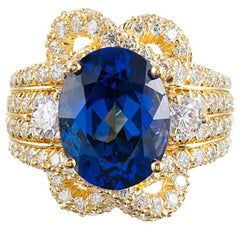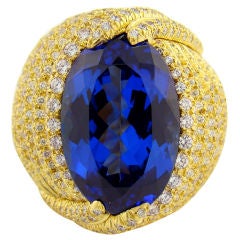Henry Dunay Tanzanite Ring
Recent Sales
21st Century and Contemporary Cocktail Rings
Diamond, Tanzanite, 18k Gold, Yellow Gold
20th Century Fashion Rings
Diamond, 18k Gold
Late 20th Century Cocktail Rings
Diamond, Tanzanite, 18k Gold
Henry Dunay for sale on 1stDibs
Henry Dunay is one of the finest goldsmiths and jewelry makers of the 20th century. The seasoned American designer has for decades created exquisite jewelry by hand that is characterized by bold proportions and precise craftsmanship. Dunay’s breathtaking brooches, bracelets, rings and other accessories have garnered worldwide renown and — on the secondary market — are being reappraised by collectors as icons of contemporary design.
Dunay was born Henry Loniewski in Jersey City, New Jersey, and apprenticed for a downtown New York City jeweler named Rudolph Cacioli in his early teens. He spent a little less than seven years working under Cacioli, and set off to open his own business in 1956. He took on his mother's maiden name Dunay, believing his family name would be an obstacle to his success. At first, Dunay secured work designing pieces for other jewelers, including Harry Winston, one of the first figures in the field to recognize the branding power of lending glitzy fine jewelry for red-carpet events. As his skill set broadened, Dunay began handcrafting his own designs and built a name for himself.
Dunay’s business exploded thanks to the publicity around the De Beers Diamonds International Award he won in 1967. From then on, his fame grew and demand increased for his unique adornments, which feature distinctive metal finishes as well as blue sapphires, pavé set diamonds and a range of other gems. Dunay went on to win more awards from De Beers Diamonds and a wealth of other national and international awards throughout his career.
Dunay garnered acclaim for a sophisticated engraved-surface technique he calls Sabi, which draws on the traditional Japanese philosophy of wabi-sabi, and iconic figures such as Elizabeth Taylor, Nancy Reagan and Princess Diana all wore his elegant pieces for public appearances. At the 2003 Academy Awards, many celebrities donned Dunay’s Dove of Peace pin, commissioned by Global Vision for Peace and inspired by the work of Pablo Picasso. The designer is a member of the Gemological Institute of America and a past president of the American Jewelry Design Council. In 2009, he sold his company and later established H.D.D., Inc.
Find vintage Henry Dunay necklaces, earrings and other jewelry on 1stDibs.
The Legacy of Diamond in Jewelry Design
Antique diamond rings, diamond tiaras and dazzling vintage diamond earrings are on the wish lists of every lover of fine jewelry. And diamonds and diamond jewelry are primarily associated with storybook engagements and red-carpet grand entrances — indeed, this ultra-cherished gemstone has a dramatic history on its hands.
From “A Diamond Is Forever” to “Diamonds Are a Girl’s Best Friend,” pop culture has ingrained in our minds that diamonds are the most desired, the most lasting and the most valuable gemstone. But what makes the diamond so special? Each stone — whether it’s rubies, sapphires or another stone — is unique and important in its own right. April babies might claim diamonds for themselves, but just about everyone wants this kind of sparkle in their lives!
There are several factors that set diamonds apart from other stones, and these points are important to our gem education.
Diamonds are minerals. They are made up of almost entirely of carbon (carbon comprises 99.95 percent; the remainder consists of various trace elements). Diamonds are the hardest gemstones, ranking number 10 on the Mohs Hardness Scale. Even its name, diamond, is rooted in the Greek adamas, or unconquerable. The only object that can scratch a diamond is another diamond. Diamonds are formed deep within the earth at very high temperatures (1,652–2,372 degrees Fahrenheit at depths between 90 and 120 miles beneath the earth’s surface) and are carried up by volcanic activity. Diamonds are quite rare, according to the Gemological Institute of America, and only 30 percent of all the diamonds mined in the world are gem quality.
In the 1950s, the Gemological Institute of America developed the 4Cs grading system to classify diamonds: clarity, color, cut and carat weight. Not all diamonds are created equal (there are diamonds, and then there are diamonds). The value of the diamond depends on the clarity (flawless diamonds are very rare but a diamond's value decreases if there are many blemishes or inclusions), color (the less color the higher the grade), cut (how the diamond’s facets catch the light, certain cuts of diamonds show off the stone better than others) and carat weight (the bigger, the better).
When you start shopping for a diamond engagement ring, always prioritize the cut, which plays the largest role in the diamond's beauty (taking the time to clean your diamond ring at least every six months or so plays a role in maintaining said beauty). And on 1stDibs, a range of buying guides can be found for those in the market for antique engagement rings, vintage engagement rings or Art Deco engagement rings.
Shop antique and vintage diamond rings, diamond necklaces and other extraordinary diamond jewelry on 1stDibs.
Finding the Right Cocktail-rings for You
A flashy symbol of wealth during the early 20th century, antique and vintage cocktail rings have gained broader appeal in the decades since for the hefty dose of glamour they bring to any ensemble.
Cocktail rings earned their name for their frequent appearances during glitzy cocktail parties at the height of the Prohibition era. Back then, these accessories were seen not only as statement pieces but as statements in and of themselves. They openly represented a sense of freedom and independence as well as a demonstration of opulence. After all, the 1920s heralded the Harlem Renaissance and Art Deco design, and a slew of social and cultural shifts meant that women in particular were breaking from pre–World War I conventions and embracing newfound freedoms to express themselves as individuals.
Women expressly wore cocktail rings on the fingers of their right hand versus the left, which was “reserved” for an engagement ring or wedding band, accessories definitely paid for by a suitor. And for cocktail rings, the bigger the colored gem at the center — which is usually mounted in a high setting — and the more elaborate the design, the stronger the likelihood of being noticed.
Cocktail rings remained a popular piece of jewelry for women until the 1930s, when the Great Depression and the onset of war marked a change in behaviors nationwide. While the 1960s and ’70s saw a return in visibility for the accessory, it wasn’t until the 1980s that cocktail rings once again assumed their position as a beacon of luxury and glitz.
During the 20th century, the range of dazzling cocktail rings seems to have been limitless, from glimmering gold rings set with carved jade diamonds designed by David Webb to Pomellato’s pink quartz confections to striking Gucci butterfly rings with accent diamonds set in a pavé fashion.
So, how do you wear a cocktail ring? Cocktail rings “can be worn for almost anything — dinners, date nights, parties, special events, on the red carpet,” explains David Joseph of New York-based jewelry brand Bochic.
Can you wear cocktail rings with other rings? “In my opinion, cocktail rings should stand on their own since they showcase a large gem in the center,” says Joseph.
These glamorous jewels can be worn inside or outside crowded taverns, in either daytime or nighttime with casual or dressy attire. On 1stDibs, find a wide variety of antique and vintage cocktail rings, including those offered by Chanel, whose elegant cocktail rings often feature pearls and, of course, diamonds, and sometimes were styled after showy flowers like the camellia, and Van Cleef & Arpels, whose detailed and intricate designs are viewed as miniature pieces of wearable art.

